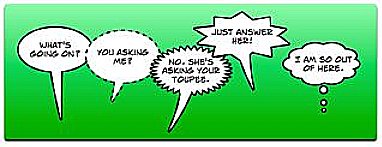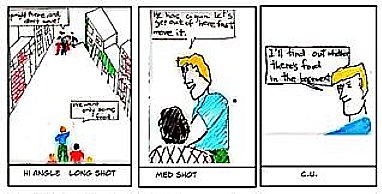Comic Book Planning
With Your Students!
The Real World content advantage of comic books is cross-curricular. The use of comic books is an adventure in subject integration... as seen through the eyes of a videographer.

If you work comics into your course of study, you have excellent options for partnering with at least one other department colleague to help students add valuable insights from skill sets across the curriculum.
Planning for a comics project is key to best results.
Before planning a response project, students can pool their knowledge about this powerful storytelling medium. Depending on culture and experience, some students will have more facility with comic books and their conventions or elements than others.
Lead off with a little investigative group work. Form groups to include both experienced and inexperienced comic book readers. Focus on surveying comic book content to compile a list of common structures and elements or features.
For example:
* How many different purpose speech balloons can the group find?

* How is a change in setting illustrated?
* How are sets shown? How are you able to figure out where the story takes place? What single object or group of objects does the artist choose to represent a setting?
* How is a jump in time or distance indicated?
* How is a flashback shown?
* How many camera angles can you identify? Points of view?

Once basic elements are charted or otherwise shared, students can plan their own comic book vehicle either individually or in small, creative-teamed groups.
What topics are available for comic book creation? Every school subject has dozens of possibilities. Keep the first venture short.
In the planning stage we need to decide how long the comic is to be. Is this a single strip of three to four frames? Is it to be a full page layout of six to eight or ten frames?

Will it be an episode in comic format of something students have read? An instructional illustration of a procedure? A new story creation? A biographical nugget from a famous, subject-specific life?
Is it a report? Is it a genre story?
How many characters will we need?
In the first of a series of comics projects, help limit choices so, at the very least:
guidelines are clear,
the amount of work to do is reasonable,
there is a time limit,
and a maximum physical length for projects.
The other bonus teaching tool in a planning discussion with students is the development of a marking system. This may be very general – a pass-fail or simple rank of “present” from a list of required elements.
Planning with students affords choices that students can agree on about comic strip elements that, where present, satisfy a pedagogical requirement. Keep this requirement simple so that marking is not only simpler for you but also easily understood by all participants. A class-developed evaluation contract is a terrific teaching tool.

Return from Comic Book Project Planning to Comic Books hub page for even more comic book teaching ideas!
Return from Comic Book Project Planning to Real World Content Advantage home page.